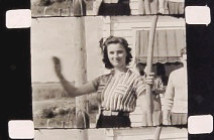Tom Robinson reports on the busy Home Movie Day in Eugene, Oregon.
About 200 people showed up at the University of Oregon’s first HMD yesterday, many carrying collections of film. We attribute the big turnout to the heavy media coverage; both local television stations sent film crews in advance and gave us coverage on all Friday newscasts, complete with old home movie samples. The newspaper put us on the cover of the living section and the top of the front page. The posters helped too.
We had three screens simultaneously showing films, three intake tables and an army of helpers. The projectors were arranged in the center of a screening room, with screens on three different walls. One screen had two 16mm Eiki SSL projectors, the other two screens each had both regular 8mm & super 8mm projectors. We were loading film on one projector while the other was playing movies. For most of the afternoon we were able to have all three screens going at the same time. Two of the three super 8 projectors failed in the first hour, one burned up a motor, a clutch failed on another. Other than that everything worked well.
We did not have advance intake. Patrons checked in with a receptionist, who directed them to the proper intake table (different film gauges). Intake would put a stickie on each film reel, can or box labeled with the family name. The intake person would then give the films back to the patron and a “patron relation liaison” would escort the patron to the projection room, where there was a second intake table next to the projectors. Patrons would put a few films in the “inbox”. As projectors became available for loading, projectionists would ask the projection intake person for a new reel of whatever gauge film. Each projectionist would announce the family name on the film at the point of loading the projector, saying which screen the film would be on, so the family could get to the area near the screen that was going to show their film. The projectionist would again announce the family name at the beginning of each film, so people would know when their films were starting. Patrons were always in possession of their film and the only time we had it was when we were projecting it. There were no claims of lost film, etc.
Next year we will do a more thorough job of examining film at intake to determine whether it is wound on the patron’s reels properly, that it is heads out, emulsion out, that regular/super 8 is on the correct spindle size reel, leader (if any) is securely fastened and that the film is not broken in the middle. Our top problem (aside from being mobbed) was old splices falling apart during projection; we had to have splicing blocks at the projectors and used them quite a bit. Our projectionists (including yours truly) worked non-stop. next year we want to have to have matched sets of four projectors, dedicated regular 8 and dedicated super 8, and two extra projectors for motorized rewinding. We want four screens next year, with a set of small gauge projectors for each of the 4 screens. And we want more of those little gooseneck clamp-on lights to thread projectors with. and a string of xmas tree lights around the perimeter of the projector area, since patrons coming in from the street have to take time to adjust to the dark of the screening room and a few couldn’t see very well.
Probably the oldest HM was 1927, a double sprocket 16mm with vs, brought in by a very elderly lady, showing her as a little girl. We probably screened about 50 movies, the vast majority being evenly divided between regular 8 and super 8, reel sizes from 3” to 7”, and there was a surprising amount of 16mm. We had people crying, whole families came in together, a tv crew filmed inside the event for the evening news, it was a full house and our hands were full from beginning to end.

